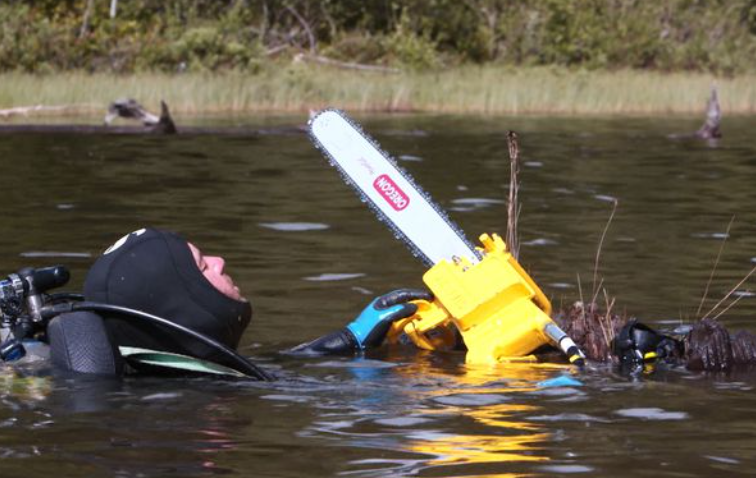
Jenny White McKee is underwater but she cannot see a thing. The air bubbles from her scuba rig rise from a cloud of mud and dead plant matter stirred up from the bottom of the lake. A large stump looms in front of her, rising to the surface. Then, there’s a sound like the creek of an ancient door hinge. It is the eerie twist of metal into wood.
The noise carries through the water and, as White McKee says, it “makes your skin crawl.” White McKee is a diver with the United States Geological Survey. Pete Dal Ferro is helping her on this project. He’s a fellow diver. The divers are using a t-shaped tool called an increment borer into the submerged tree to get a straw-sized plug of wood. Despite the diving conditions being rough, the payoff should be satisfying. The hope is that the tube of wood will help researchers figure out when the tree died. As a result, it should reveal when a massive earthquake shifted the ground on the Olympic Peninsula and formed Price Lake.
The Pacific Northwest has dozens of earthquake faults. Most are shallower and closer to where people live than the Cascadia subduction zone offshore. It roughly parallels the coastline. Researchers are considered if Cascadia “ruptures” because it would most likely affect the entire West Coast. Of course, there are other locations to be concerned about particularly near Seattle, Washington.
Trees are helpful in determining seismic activity because they record, within the chemical and physical composition of their wood, everything that happens to them whether it’s a big storm, a decade of draught or an earthquake, among other things. Tree ring growth is heavily influenced by climate. This means that trees of the same species growing in the same region will show similar ring patterns. Scientists who understand tree rings can then piece together the story about what has happened to a landscape in the past.
Radiocarbon is another tool that can help researchers understand seismic or historical events of a landscape. Radiocarbon in our atmosphere sometimes has huge events known as radiocarbon excursion events. They’re global so we can get a good deal of data by using this process. Well, researchers can. How? Every tree on the planet that was alive during one of these seismic events will have a radiocarbon spike in that year’s ring. Over the past two thousand years, two such events, one in 774 and the other in 993, have caused such a phenomenon to occur.
Using this technique, scientists hope to figure out the exact six-month period when this particular submerged forest died. If they all died at the same time, then it’s safe to assume that an epic event like an earthquake did occur. Another possibility is that the faults all slipped in rapid succession, perhaps a few years apart. The knowledge may be helpful in giving emergency planner a better idea of what to expect when the next earthquake hits the Puget Sound region.
Unfortunately, the samples of wood extracted using the increment borer are not too helpful. Why? After being underwater for 1,000 years, the wood has turned to mush. To solve this problem, they’re going to use an underwater chainsaw. They choose a tree that is pretty close to the surface and in clear water. A tree that size should have quite a few rings. Dal Ferro performs the surgical cut and it’s not easy. However, they get the samples they need and are hopeful that the results will be instrumental in indicating what happened to these trees more than a thousand years ago.
Wow! We think that this type of research is ground-breaking and exciting. We hope you feel the same way. We always enjoy bringing you new information related to tree news from around the world. We’re grateful for your readership.











